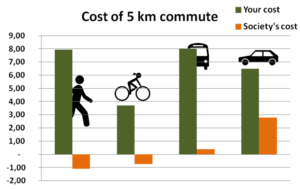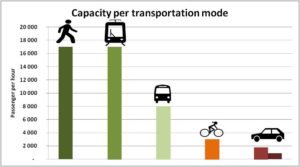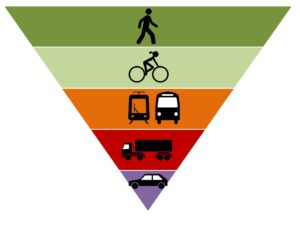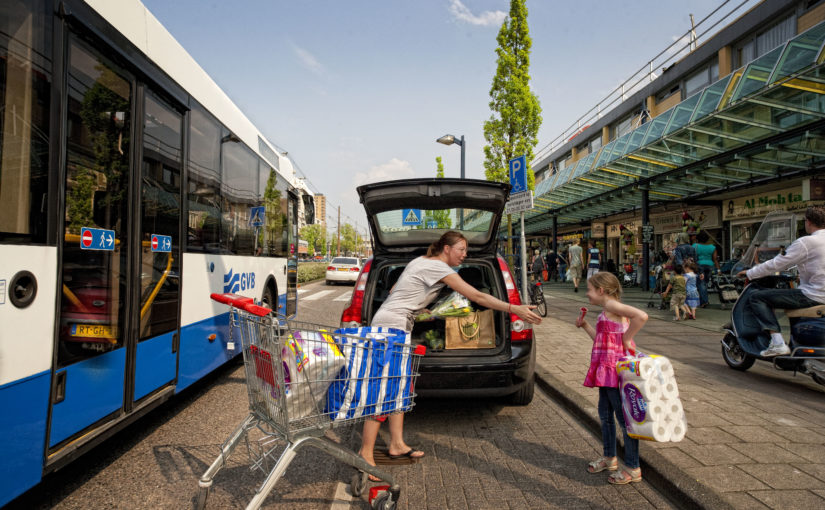Alternative transportation – Enabled by technology
Alternative transportation is a key component in sustainable cities
Today’s city transportation system is ineffective and inequitable. It consumes scarce and expensive space. The design assumption has for the past 50 to 100 years been that the private car is the dominant mode of transport. This has lead to serious pollution and congestion of our large and growing cities. The situation in the megacities of the world is on the border of what human beings can withstand. In some, one can argue, even beyond what is human. It is not a sustainable situation from a global perspective. The main culprit being the private car and our habit of using it for commuting. Therefore, we need to drive a modal shift to alternative transportation modes. Cities need to plan to facilitate walking and cycling firstly, supported by a backbone of various public transportation alternatives.
Parking space occupies valuable real estate
Approximately 60% of the built-up area in cities is infrastructure. The prices of real estate in the cities are increasing as the cities grow and are getting denser. Hence, the cost of the infrastructure keeps going up after the construction of it is finished, the alternative cost that is. Considering that parked cars generally occupy 25% of the infrastructure. These parked cars are used only 3% of the time on average. This seems even more of a major waste of valuable land. Furthermore, the need for underground parking spaces in connection to apartment building is driving up the cost for the apartments, even for those without parking. Furthermore, parking garages have the potential to be converted to in-expensive housing. The cities should be for people and not big metal boxes.
The societal cost of commuting by car is far higher than the cost the individual commuter pays

The space in-effiency of private cars is fundamental. If we were to design an urban transportation system from scratch it would not rely on private cars. Car commuters often complain of the costs of the car, costs for petrol, parking, taxes, etc. When cities introduce congestion charging it is often met with an uproar among commuters as their costs go up. However, commuting by car costs a lot more to society than what the commuter pays.
The space requirement has an impact on the capacity of the transportation mode. Where walking and trams provide the highest capacity of all the urban transportation means with 17,000 passengers per hour, while buses have less than half the capacity. Cycling in bike lanes provides a further less than half the capacity of buses. Traveling by car on the streets ends up in the bottom with 900 passengers per hour.

How to drive modal shift?
All available data speaks against the private car as a transportation solution. However, commuting by car is a habit, and habits are hard to change. It is convenient in the way that it is available at our doorstep and is an extension of our home, our private sphere moving in the city. Therefore the city government should drive a modal shift. Reducing space available for vehicles. Converting car lanes to bus lanes and bike lanes. Converting parking spaces and car parks to housing. At the same time the alternative transportation has to be made competitive, convenient, attractive and safe. Developing tram lines, bus rapid transit systems and bike share programs carefully timed to hikes in parking costs and reduction of parking availability. Self-driving taxis and introduction of Mobility-as-a-Service will simplify the transition.
Technologies to enable the modal shift

Driving a modal shift means driving behavioral change. Technology can help in the following ways:
- Information technology making information available to simplify traveling with public transport. This is information on time tables, fares, bike share programs, park-and-ride facilities, etc.
- Incentives for the desirable behavior.
- Enforcement of the undesirable behavior.
A combination of incentives for the desirable behavior and enforcement of undesirable behavior has the highest likelihood of success.
Information technology
In order for the habitual driver to chose public transport instead, information needs to be easily available. It is preferably collated and presented in a way the decisions can be made quickly. The providers of city’s transportation systems need to have solid strategies for sharing and presenting information. Information should not only be provided in apps, time tables and on screens, but also shares in open formats with information brokers and other information service companies.
The city’s whole information system infrastructure need to be designed to support the shift. For instance by guiding the drivers to park-and-ride-facilities.
Traffic management technologies
There is a whole range of traffic management technologies and ITS (Intelligent Transportation Systems) that can drive the modal shift. Congestion charging, city access control or environmental zone systems are making the alternatives more attractive while reducing the number of vehicles entering the city. Parking guidance systems will reduce the traffic in the city by providing accurate information to the drivers. Automatic enforcement systems can be applied to protect dedicated bus lanes as well as bike lanes. The bus lane enforcement system detects that a vehicle that do not belong in the bus lane and will consequently register and fine the violator. Bike lane enforcement works in the similar way.
The vulnerable road users should feel safe in order to support walkability and cyclability. Speed and red-light enforcement systems can be deployed for this purpose. Furthermore speed warning systems and non-ticketing strategies can be used for a complementary and softer push from cars to the alternatives.
Summary – Paving the way for alternative transportation
Alternative transportation is key to make cities sustainable. Encouraging walking and cycling has the highest priority for health, space and capacity reasons. Side walks, pedestrian safety, bike sharing schemes, protected bike lanes and bike lane enforcement are examples of schemes to drive this priority. Adding speed and red-light enforcement as well as speed warning systems will help to protect the vulnerable road users. Trams, buses and the subway should be the backbone of the transportation system. Information systems, dedicated bus lanes and bus lane enforcement are examples of initiatives that can support this backbone.
Private cars ought to have the lowest priority due to negative effects on the city’s economy, population and the environment. Congestion charging, access control and environmental zones are traffic limiting systems that has the potential to drive people to alternative transportation. These systems are also minimizing the impact of the traffic that remains.
Sources
Sustainable Urban Mobility Plan, Malmö City: http://malmo.se/download/18.16ac037b154961d0287b3d9/1463565891865/MALM_TROMP_210x297mm_ENG.pdf
George Poulos: http://movingforward.discoursemedia.org/author/george-poulos/
TÖI, Norwegian Center for Transport Research: https://www.toi.no/publications/category29.html
